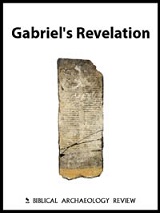
Christopher Rollston examines the Qeiyafa Ostracon, Gezer Calendar and other inscriptions in a search for the oldest Hebrew script and language.
In the BAR article What’s the Oldest Hebrew Inscription*, epigraphy scholar Christopher Rollston asks a seemingly straightforward question: What is the oldest Hebrew inscription? His examination requires him to address the fundamental questions of epigraphy. Is a text written in Hebrew script necessarily in the Hebrew language? And was the Hebrew language originally written in an alphabet that predates Hebrew script? Christopher Rollston examined four contenders for the oldest Hebrew inscription—the Qeiyafa Ostracon, Gezer Calendar, Tel Zayit Abecedary and Izbet Zayit Abecedary—to explore the interplay between early Hebrew script and language.
In his study, Christopher Rollston distinguishes between purely Hebrew script and other visually similar alphabets while examining relationships between alphabets and languages. Not only can a single language be written in various scripts, but a single script can be used for dozens of languages. English shares the Latin script with most Western languages; finding Latin letters does not necessarily mean that a text is English.

Old Hebrew script derived directly from Phoenician, and Christopher Rollston contends that Old Hebrew script did not split off from its Phoenician predecessor until the ninth century B.C.E. The Hebrew language existed well before then; the oldest extant Hebrew language texts are recorded in Phoenician script. Identifying the oldest combination of Hebrew script and language is hindered by a diverse set of complications including the poor condition of texts, the existence of cognates, regional variation, partial language preservation, limited number of artifacts and myriad other difficulties.
Become a Member of Biblical Archaeology Society Now and Get More Than Half Off the Regular Price of the All-Access Pass!
Explore the world’s most intriguing Biblical scholarship
Dig into more than 9,000 articles in the Biblical Archaeology Society’s vast library plus much more with an All-Access pass.

The Qeiyafa Ostracon and Gezer Calendar are the best known contenders that Christopher Rollston examines. The five-line Qeiyafa Ostracon** has garnered a great deal of attention since its 2008 excavation at Khirbet Qeiyafa, the fortified tenth century B.C.E. Judahite city located on the border of Judah and Philistia. The faded text on the Qeiyafa Ostracon has challenged potential translators; what is known is that its variations and left-to-right orientation signal a pre-Hebrew script deriving from Early Alphabetic rather than Phoenician writing. Most scholars agree with Christopher Rollston about the type of script, but he suggests that the language may not be Hebrew. The lexemes, or word roots, could come from one of several Semitic languages. This interpretation of the Qeiyafa Ostracon raises a new set of questions. Could the Qeiyafa Ostracon be from a non-Judahite site? Or could another language have been the lingua franca of the period? More simply, could the text have been imported from elsewhere, or written by a foreigner? The Qeiyafa Ostracon is a significant puzzle piece in the development of Hebrew writing, but there are still too many unanswered questions for the Qeiyafa Ostracon to be considered the oldest Hebrew inscription.
Visit the BAS Scholar’s Study page Three Takes on the Oldest Hebrew Inscription.
The Gezer Calendar is a small limestone tablet listing seasonal agricultural activities in seven lines of uneven letters. Scholarly opinions on the Gezer Calendar have shifted over the past century of scholarship. In 1943, William Foxwell Albright stated that “the Gezer Calendar is written in perfect classical Hebrew.” More recent scholarship questioned the idea that the Gezer calendar has distinctively Hebrew script or language. Christopher Rollston contends “there is no lexeme or linguistic feature in the Gezer Calendar that can be considered distinctively Hebrew” and Joseph Naveh says that “No specifically Hebrew characters can be distinguished.” Christopher Rollston concludes that the Gezer Calendar is written in Phoenician rather than Hebrew script, though the late tenth or early ninth century B.C.E. includes elements described by Frank Cross as “the first rudimentary innovations that will mark the emergent Hebrew script.”

Christopher Rollston
Rollston continues his analyses on some other contenders for the oldest Hebrew inscription. He finds the Tel Zayit Abecedary to be fully Phoenician script, despite the excavation epigrapher claiming that the abecedary indicates the transition between the scripts. Finally, the oldest contender, the Izbet Sartah Abecedary, which dates to roughly 1200 B.C.E., predates the development of any Hebrew script, and appears to be written in Early Alphabetic script, which is not closely related to Old Hebrew script. While some scholars have presented these and other Iron Age I inscriptions as Hebrew script, Rollston suggests that we have to look to a slightly later period to find the first Hebrew language recorded in a purely Hebrew script.
Subscribers: Read Christopher Rollston’s detailed analysis of the Gezer Calendar, Qeiyafa Ostracon and several other inscriptions in What’s the Oldest Hebrew Inscription? in the May/June 2012 issue of Biblical Archaeology Review.
Not a BAS Library or All-Access Member yet? Join today.
Notes:
* What’s the Oldest Hebrew Inscription? from the May/June 2012 issue of Biblical Archaeology Review.
** To read more on the Qeiyafa Ostracon’s inscription, read Gerard Leval’s Ancient Inscription Refers to Birth of Israelite Monarchy from the May/June 2012 issue of Biblical Archaeology Review.
Not a BAS Library or All-Access Member yet? Join today.Related reading in Bible History Daily:
This Bible History Daily feature was originally published on June 4, 2012.
The post The Oldest Hebrew Script and Language appeared first on Biblical Archaeology Society.


0 Commentaires